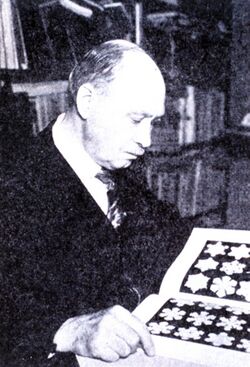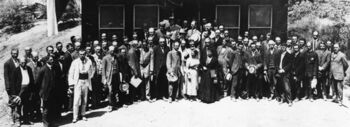Biography:William Jackson Humphreys
William Jackson Humphreys | |
|---|---|
 | |
| Born | Gap Mills, Virginia |
| Died | November 10, 1949 (aged 87) |
| Awards | Howard N. Potts Medal (1916) |
| Scientific career | |
| Doctoral advisor | Henry Augustus Rowland |
William Jackson Humphreys (February 3, 1862 – November 10, 1949) was an American physicist and atmospheric researcher.
Biography
Humphreys was born on February 3, 1862, in Gap Mills, Virginia, to Jackson and Eliza Ann (née Eads) Humphreys.[1] He studied physics at Washington & Lee University in Virginia and later at Johns Hopkins University in Baltimore, where he earned his Ph.D. in 1897, studying under Henry Augustus Rowland.[2]
He worked in the fields of spectroscopy, atmospheric physics and meteorology. In the field of spectroscopy he found the shift of spectral lines under pressure. In atmospheric physics he found a very good model for the stratosphere in 1909. He wrote numerous books, including a textbook titled Physics of the Air, first published in 1920 and considered a standard work of the time,[2] though it was last published in 1940.[citation needed] He also held some teaching positions at universities. He concluded that the 1815 eruption of Mount Tambora was responsible for the subsequent cooling known as the Year Without a Summer.[3]
From 1905 to 1935 he worked as a physicist for the U.S. Weather Bureau, predecessor of the National Weather Service.[2] In 1919, he served as president of the Philosophical Society of Washington.[4] He was elected to the American Academy of Arts and Sciences in 1921.[5] In 1924 he was an Invited Speaker of the ICM in Toronto.[6] He was elected to the American Philosophical Society in 1929.[7]
He died on November 10, 1949, in Washington, D.C.
Bibliography
- Physics of the Air (1920)
- Weather proverbs and paradoxes (1923)
- Fogs and clouds, The Williams & Wilins Co. (1926)
- Rain making and Other weather vagaries (1926)
- Snow crystals (1931)
References
- ↑ Hockey, Thomas (2009). The Biographical Encyclopedia of Astronomers. Springer Publishing. ISBN 978-0-387-31022-0. http://www.springerreference.com/docs/html/chapterdbid/58667.html. Retrieved August 22, 2012.
- ↑ 2.0 2.1 2.2 "NOAA History - Profiles in Time/NWS Biographies". National Oceanic and Atmospheric Administration. http://www.history.noaa.gov/nwsbios/nwsbios_page36.html. Retrieved 2011-11-09.
- ↑ "The year without a summer". https://climate.nasa.gov/blog/183.
- ↑ Humphreys, W. J. (1930). "The Philosophical Society of Washington through a thousand meetings". Journal of the Washington Academy of Sciences 20 (13): 245–316. ISSN 0043-0439. https://www.jstor.org/stable/24523672.
- ↑ "William Jackson Humphreys" (in en). 2023-02-09. https://www.amacad.org/person/william-jackson-humphreys.
- ↑ Humphreys, W. J.. "The effect of surface drag on surface winds". In: Proceedings of the International Congress of Mathematicians in Toronto, August 11–16. 1924. 2. pp. 297–304.
- ↑ "APS Member History". https://search.amphilsoc.org/memhist/search?creator=William+J.+Humphreys&title=&subject=&subdiv=&mem=&year=&year-max=&dead=&keyword=&smode=advanced.
 |


